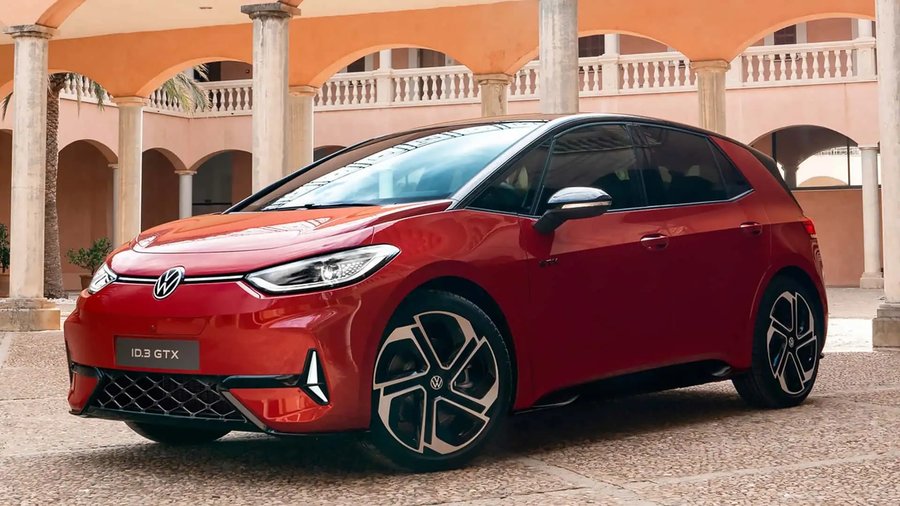New Volkswagen ID.3 GTX And ID.7 GTX Tourer Come With More Power, Sporty Looks

A performance-oriented ID. Buzz GTX is also in the works, completing the GTX lineup of EVs that was started back in 2021 with the launch of the ID.4 GTX and ID.5 GTX.
We’ll start with the ID.7, since this one has the biggest chance of coming stateside, at least in fastback form, since the Tourer won’t be sold here. However, it’s exactly the Tourer version that gets the spotlight this time around because it is officially the most powerful wagon the German car manufacturer has ever made.
ID.7 GTX
Thanks to its dual-motor, all-wheel drive setup, the new Volkswagen ID.7 GTX Tourer makes a total of 250 kilowatts (335 horsepower), 40 kW (53 hp) more than the most powerful non-GTX ID.7 available. The rear APP550 permanent magnet synchronous motor on the rear axle makes 210 kW (281 hp), while the front AKA150 asynchronous motor puts out 80 kW (107 hp).
An 86-kilowatt-hour battery pack is the only power source available for the ID.7 GTX Tourer, the same that’s offered for the ID.7 Tourer Pro S. It can be recharged at up to 200 kW from a compatible DC fast charger, meaning that a 10 to 80% top-up can take less than 30 minutes in ideal conditions.
Volkswagen didn’t say how quickly the ID.7 GTX Tourer accelerates, but it did mention that the performance-oriented family EV “delivers maximum power and torque in a fraction of a second when accelerating.” But that’s valid for all modern EVs on the market, so take that as you may. The maximum speed is electronically limited to 180 kilometers per hour (111 miles per hour).
Compared to the rear-wheel drive-only ID.7 Tourer, the GTX comes with a different bumper with a honeycomb grille and a different light design that’s specific for GTX models. The outer roof frame strips are also painted black, as are the side mirrors, side sills, and the lower area of the rear bumper.
Inside, the maximum storage capacity of 1,714 liters (60.5 cubic feet) of the regular ID.7 Tourer is carried over to the GTX. However, VW has fitted GTX-specific seats to the sporty electric family hauler that come with red decorative seams and perforated red lettering in the backrests.
The Volkswagen ID.7 GTX also comes as standard with a specially tuned chassis, sportier steering, LED matrix headlights, LED tail light clusters with dynamic turn signals, tinted glass in the rear, 20-inch alloy wheels, and 30-color instead of 10-color background lighting. The sporty family EV also gets an enhanced augmented reality head-up display, wireless Apple CarPlay and Android Auto, dual-zone automatic climate control, and the IDA voice assistant that integrates with ChatGPT.
ID.3 GTX and ID.3 GTX Performance
The smallest of the ID family of EVs, the ID.3, also gets the GTX makeover almost five years after its debut in 2019. And to make up for lost time, Volkswagen fitted the most powerful version of its APP550 electric motor to date in the back of the compact electric hatchback.
In GTX Performance guise, the ID.3 makes a rather impressive 240 kW (321 hp) from just a single electric motor, whereas the previously mentioned ID.7 GTX Tourer has the same power output from two electric motors. At the same time, there’s an ID.3 GTX (non-Performance) that makes 210 kW (281 hp), the same as the single-motor ID.7. Torque is rated at 545 Newton-meters (401 pound-feet) for both output levels.
Volkswagen says the performance EV is more powerful than its most potent V6 turbocharged engines. The sporty ID.3 GTX needs 6 seconds to accelerate from zero to 62 mph (0-100 kph), while the more potent ID.3 GTX Performance cuts the time to 5.4 seconds. Top speed is limited to 180 kph (111 mph) and 200 kph (124 mph), respectively.
A bigger, 79-kWh (net) battery pack comes as standard for both versions of the ID.3 GTX. Besides being 2 kWh bigger than what’s available in the top-spec non-GTX ID.3, the new battery also increases the maximum DC charging speed from 170 kW to 175 kW. This means a 10 to 80% top-up can take about 26 minutes when connected to a compatible DC fast charger. The ID.3 GTX also features a battery pre-conditioning system that is enabled automatically when using the car’s built-in navigation system, or it can be enabled manually.
Volkswagen claims the expected combined WLTP driving range is roughly 600 km (372 miles). By comparison, the non-GTX ID.3 with the 77-kWh battery has a WLTP range of 5346 km (339 miles), while the entry-level model with the 58-kWh pack can travel for up to 426 km (264 miles), according to the WLTP testing.
Much like the bigger ID.7 GTX Tourer, the ID.3 GTX comes with a redesigned front bumper that integrates a pair of triangular LED daytime running lights, high-gloss black elements on the exterior, and 20-inch wheels. Inside, the compact EV features premium sport seats with red stitching as standard, as well as a new generation of the automaker’s infotainment system that includes ChatGPT integration and a 12.9-inch touchscreen.
The Volkswagen ID.7 GTX Tourer, ID.3 GTX, and ID.3 GTX Performance will go on sale in Europe later this year.
Related News
